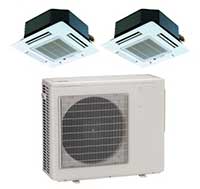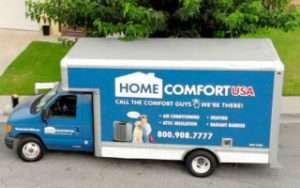

Updated 7/11/2024
Heating, Ventilation, and Air Conditioning (HVAC) systems play a crucial role in maintaining comfortable indoor environments in homes and businesses. As technology advances and energy efficiency becomes increasingly important, it’s essential to understand the various types of HVAC systems available, factors to consider when upgrading, and industry trends shaping the future of home comfort.
Mini-Split HVAC System Details
Mini-split HVAC systems have gained popularity due to their efficiency and flexibility. Let’s explore their components and benefits:
Components of a Mini-Split System
- Outdoor Unit: A condenser or heat pump
- Indoor Air Handlers: Multiple units placed in different rooms
- Connecting Cables: Transport refrigerant between outdoor and indoor units
Benefits of Mini-Split Systems
- Energy Efficiency: Cool specific rooms rather than the entire house
- Flexible Installation: Require only small access points for cables
- Zoned Comfort: Control temperature in individual rooms
- No Ductwork: Eliminates energy loss through ducts
- Discrete Design: Indoor units can be mounted on walls, ceilings, or floors
Installation and Range
- Cable length: Up to 230 feet linear distance
- Height capability: Up to 160 feet
- Suitable for most residential applications
Parts of a Mini-Split HVAC System
The simple mechanics of a mini-split HVAC system is what makes them so efficient. There are two basic elements to a mini-split HVAC system: an outdoor condenser or heat pump and a series of indoor air handlers. When your air conditioning is in use, the outdoor unit sends a refrigerant solution through a cable to your selection of specific indoor air handlers.
The cables used today can have a linear distance of up to 230 feet and can be up to 160 feet high. This is enough length to easily accommodate most residences. Home Comfort USA requires only a small access point to install these cables, which is much cheaper and much easier than installing an entire ductwork system throughout your home.
Learn more about HVAC systems with HVAC Zoning System and Heat Pump Systems and HVAC Maintenance Tips.
The latest in mini-split HVAC systems are capable of using only a single outdoor unit to connect to several indoor air handlers. The various air handlers throughout your house are controlled by either a touch panel or a remote. This gives you complete control over how hot or cold you’d prefer each room to be. With a mini-split HVAC system, you can enjoy the most comfortable with the highest possible energy-efficiency.
Benefits of a Mini-Split HVAC System
Home Comfort USA will allow you to choose where you would like to place the air handlers throughout your house. They can be mounted on ceilings, walls, and even floors. You’ve worked hard decorating your house to make it your own, so we will go the extra mile so that our air handlers are discrete and will not affect the look of the room.
Mini-split HVAC systems do not rely on ductwork to divert air throughout your house. This will save you money each month since the hot or cold air generated by the outdoor unit will not be lost traveling through the ductwork. You will also save money long-term since you will not have to maintain or repair the ductwork used in a traditional HVAC system.
Factors to Consider When Replacing an HVAC System
When it’s time to upgrade your HVAC system, consider the following factors:
- Home Size and Layout: Ensure the system is properly sized for your space
- Energy Efficiency: Look for high SEER (Seasonal Energy Efficiency Ratio) ratings
- Climate: Choose a system suited to your local weather conditions
- Existing Infrastructure: Consider whether you have ductwork or need a ductless solution
- Budget: Balance upfront costs with long-term energy savings
- Indoor Air Quality Needs: Consider integrated air purification options
- Smart Home Compatibility: Look for systems with smart thermostat integration
- Warranty and Service: Choose a reputable brand with good customer support
Top HVAC Brands and Manufacturers
Several well-known brands dominate the HVAC market, each offering unique features and benefits:
- Trane
- Known for: Reliability, innovation
- Product line: Central air, heat pumps, furnaces
- Carrier
- Known for: Energy efficiency, wide product range
- Product line: Air conditioners, heat pumps, ductless systems
- Lennox
- Known for: High-efficiency models, quiet operation
- Product line: Air conditioners, heat pumps, furnaces
- Rheem
- Known for: Affordability, solid performance
- Product line: Air conditioners, heat pumps, water heaters
- Ruud
- Known for: Durability, value for money
- Product line: Air conditioners, heat pumps, furnaces
- Day & Night
- Known for: Budget-friendly options, reliable performance
- Product line: Air conditioners, heat pumps, packaged systems
HVAC Industry Trends
The HVAC industry is evolving to meet new challenges and consumer demands:
1. Sustainability and Energy Efficiency
- Paris Agreement Impact: Driving development of low-emission HVAC technologies
- U.S. Environmental Protection Agency (EPA) Regulations: Encouraging adoption of eco-friendly refrigerants
- Energy Star Certification: Promoting high-efficiency HVAC systems
2. Indoor Air Quality (IAQ) Focus
- Clean Air in Buildings Challenge: Initiative to improve IAQ in public and private buildings
- Advanced Filtration: Increased use of MERV filters for better air purification
- Ultraviolet-C Systems: Integration of UV-C light for air and surface disinfection
- Dehumidifiers: Growing demand for integrated humidity control solutions
3. Smart Controls and Connectivity
- Wi-Fi Enabled Thermostats: Remote control and monitoring of HVAC systems
- Learning Algorithms: Systems that adapt to user preferences and habits
- Integration with Smart Home Ecosystems: Compatibility with platforms like Google Home and Amazon Alexa
4. Modular and Scalable Systems
- Variable Refrigerant Flow (VRF) Systems: Efficient solutions for larger residential and commercial spaces
- Multi-Zone Mini-Splits: Customizable comfort for different areas of the home
HVAC Maintenance Tips for Homeowners
Regular maintenance can extend the life of your HVAC system and improve its efficiency:
- Change Air Filters Regularly
- Frequency: Every 1-3 months, depending on usage and air quality
- Benefits: Improved air flow, better IAQ, reduced energy consumption
- Clean Outdoor Units
- Frequency: Annually or as needed
- Steps: Remove debris, straighten fins, clean coils
- Schedule Professional Maintenance
- Frequency: Twice yearly (spring and fall)
- Services: Refrigerant check, electrical inspection, moving parts lubrication
- Seal and Insulate Ductwork
- Benefits: Reduced energy loss, improved system efficiency
- Consider professional duct sealing for best results
- Upgrade to a Programmable or Smart Thermostat
- Benefits: Improved temperature control, potential energy savings
- Keep Vents and Registers Clear
- Ensure furniture and curtains don’t block airflow
- Monitor System Performance
- Watch for unusual noises, odors, or inconsistent cooling/heating
- Consider Air Quality Add-Ons
- Options: Whole-home humidifiers, dehumidifiers, air purifiers
- Benefits: Improved comfort and health
If you think that your air conditioning system is not energy-efficient and does not provide the comfort that you deserve, call Home Comfort USA. We will provide a free consultation to discuss what a mini-split HVAC system can do for you!





